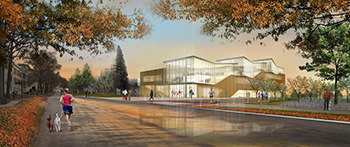Kent State Debuts New Design Loft Plans
 KENT, Ohio — Exemplifying the high level of design education and expertise offered by its architecture program, the Kent State University College of Architecture and Environmental Design’s soon to be built Design Loft is a model of innovative, forward thinking construction. The new facility will consolidate the school’s various architecture and design programs, and serve as a striking physical link between the campus and the Kent community.
KENT, Ohio — Exemplifying the high level of design education and expertise offered by its architecture program, the Kent State University College of Architecture and Environmental Design’s soon to be built Design Loft is a model of innovative, forward thinking construction. The new facility will consolidate the school’s various architecture and design programs, and serve as a striking physical link between the campus and the Kent community.
Currently the College of Architecture and Environmental Design is spread across three existing facilities, utilizing just 70,000 square feet of programming and instructional space. However, the Design Loft will bring all students under one modern, state-of-the-art roof. As the building is also targeting LEED Platinum certification, that roof will include an efficient rainwater capture system, while geothermal wells will help it maintain a comfortable and energy-efficient temperature.
Upon completion Kent State’s new 125,000-square-foot building will include a number of open studio spaces, a first floor glass library visible to pedestrian traffic, cutting edge workshops and classrooms, and a large, flat-floor auditorium. The angular, four-story facility will feature several distinct glass tiers in a staircase format, and will house the university’s interior design, urban architecture, landscape architecture and traditional architecture programs.
The design was selected through a competition hosted by the university that drew submissions from 37 different U.S. and international firms. Kent State officials ultimately selected the design team of Weiss/Manfredi of New York City, which will serve as lead architect, and Richard L. Bowen Associates of Cleveland, which will serve as the project’s architect of record.
According to the university, the $40 million facility is meant to engage the broader community in design, and to ask community members to consider how design has created their daily habitats. “We hope that the site will offer inspiration to the next generation of designers and users who will experience what it is like to have a building meld seamlessly with its environment while having a positive impact on its occupants. This is the significance of the design; it will be a reminder of what the physical environment means to our daily lives,” said the university in statement.
Inside the Design Loft a continuous staircase on the building’s north façade will allow for generous amphitheater steps that connect studio critique spaces and create opportunities for spontaneous discussion. Slender clerestory lights will bring light into the center of the floor and improve natural ventilation, while the efficient form of the building will maximize daylight and minimize energy use.
“The studio’s tiered design informs the building massing, bridging the institutional and residential scales of its neighbors,” said Weiss/Manfredi of the project. “The massing and materials of the new building reflect the material context of the campus and the surrounding community.”
Though the school will primarily serve to educate the 800 students currently enrolled in Kent State’s design and architecture programs, according to Weiss/Manfredi, the Design Loft also will function as a site for new connections. As such, the building was strategically placed at the juncture of the campus and the city of Kent. The surrounding esplanade was designed to encourage more bike and pedestrian traffic on the campus, and is also directly adjacent to the existing Lefton Esplanade.
Expanding on the theme of connections, Weiss/Manfredi and Richard L. Bowen & Associates are working alongside construction manager Gilbane Building Company to complete the project, rather than adhering to the traditional design-bid-build format. The project is currently slated for completion in time for the fall 2016 semester.
